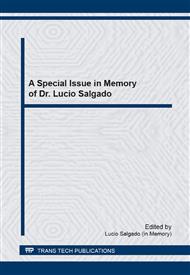[1]
Oliveira, L. S. A. F.; Oliveira, C. S.; Machado, A. P. L.; Rosa, F. P. Biomaterials for bone regeneration – Methods of analyses and future perspectives,. Revista de Ciências Médicas e Biológicas, 9 (1), pp.37-44, (2010).
Google Scholar
[2]
Barros, C. M. B. Avaliação do selamento apical em retrobturação através do MTA incorporado com diferentes veículos e materiais,. 73f. Dissertação de mestrado apresentada a Universidade Potiguar, (2008).
Google Scholar
[3]
Camilleri J. Hydration mechanisms of mineral trioxide aggregate,. Journal International Endodonty, 40, p.462, (2007).
Google Scholar
[4]
Gandolfi, M. G.; Ciapettib, G.; Taddeic, P.; Perutb, F.; Tinti, A.; Cardoso, M. V.; Meerbeekd, B. V.; Prati, C. Apatite formation on bioactive calcium-silicate cements for dentistry affects surface topography and human marrow stromal cells proliferation,. Dental Materials, 26, pp.974-992, (2010).
DOI: 10.1016/j.dental.2010.06.002
Google Scholar
[5]
McNamara, R. P.; Henry, M. A.; Schindler, W. G.; Hargreaves, K. M. Biocompatibility of Accelerated Mineral Trioxide Aggregate in a Rat Model,. Journal of Endodontics, 36 (11), pp.1851-1855, (2010).
DOI: 10.1016/j.joen.2010.08.021
Google Scholar
[6]
Torkittikul, P.; Chaipanich, A. Optimization of calcium chloride content on bioactivity and mechanical properties of White Portland cement,. Materials Science & Engineering: C, 32 (2), pp.282-289, (2012).
DOI: 10.1016/j.msec.2011.10.030
Google Scholar
[7]
Legeros, R. Z. Properties of osteoconductive biomaterials: calcium phosphates,. Clinical Orthopaedics and Related Research, 1 (395), p.8198, (2002).
DOI: 10.1097/00003086-200202000-00009
Google Scholar
[8]
Peña, J.; Vallet-Regi, M. Hydroxyapatite, tricalcium phosphate and biphasic materials prepared by a liquid mix technique,. Journal of the European Ceramic Society, 23, pp.1687-1696, (2003).
DOI: 10.1016/s0955-2219(02)00369-2
Google Scholar
[9]
Oliveira, T. C. Avaliação histológica do cimento de fosfato de cálcio (CFC) reforçado por fibras implantado supra-corticalmente em fêmur de ratos,. 52f. Tese de doutorado apresentada ao Programa de Pós-Graduação em Odontologia da Faculdade de Odontologia da Pontifícia Universidade Católica do Rio Grande do Sul, (2009).
DOI: 10.24873/j.rpemd.2018.11.236
Google Scholar
[10]
Neto, F. A. D. Avaliação do cimento de alfa-fosfato tricálcico em artrodeses tarsocrurais experimentais em cães,. 83f. Tese de doutorado apresentada ao Curso de Pós-graduação em Medicina Veterinária da Faculdade de Ciências Agrárias e Veterinárias do Campus de Jaboticabal UNESP. Jaboticabal/SP, (2007).
DOI: 10.5433/1679-0359.2020v41n6supl2p3107
Google Scholar
[11]
Kusrini, E.; Sontang, M. Characterization of x-ray diffraction and electron spin resonance: Effects of sintering time and temperature on bovine hydroxyapatite,. Radiation Physics and Chemistry, 81 (2), pp.118-125, (2012).
DOI: 10.1016/j.radphyschem.2011.10.006
Google Scholar
[12]
Oliveira, M. G.; Xavier, C. B.; Demarco, F. F.; Pinheiro, A. L. B.; Costa, A. T.; Pozza, D. H. Comparative chemical study of MTA and portland cements. Brazilian Dental Journal, 18 (1), pp.3-7, (2007).
DOI: 10.1590/s0103-64402007000100002
Google Scholar
[13]
Rigo, E. C. S.; Gehrke, S. A.; Carbonari, M. Síntese e caracterização de hidroxiapatita obtida pelo método da precipitação,. Revista Dental Press Periodontia Implantol, 1 (3), pp.39-50, (2007).
Google Scholar
[14]
Leeke, G. A.; Salimi, M. N.; Bridson, R. H.; Grover, L. M. Effect of processing conditions on the formation of hydroxyapatite nanoparticles,. Powder Technology, 218, pp.109-118, (2012).
DOI: 10.1016/j.powtec.2011.11.049
Google Scholar


